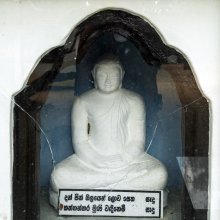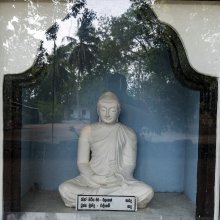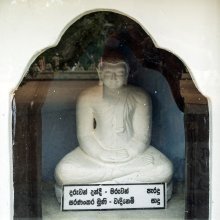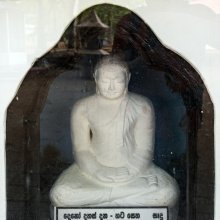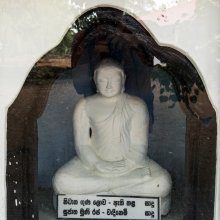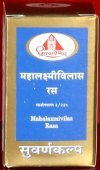Kalpa, Kalpā, Kālpa: 46 definitions
Introduction:
Kalpa means something in Buddhism, Pali, Hinduism, Sanskrit, Jainism, Prakrit, the history of ancient India, Marathi, Hindi, biology, Tamil. If you want to know the exact meaning, history, etymology or English translation of this term then check out the descriptions on this page. Add your comment or reference to a book if you want to contribute to this summary article.
Images (photo gallery)
(+4 more images available)
In Hinduism
Vaishnavism (Vaishava dharma)
Source: VedaBase: Śrīmad BhāgavatamThe four yugas are calculated in terms of the heavenly calendars and accordingly are twelve thousand years in terms of the heavenly planets. This is called a divya-yuga, and one thousand divya-yugas make one day of Brahmā.
The creation during the day of Brahmā is called kalpa, and the creation of Brahmā is called vikalpa. When vikalpas are made possible by the breathing of Mahā-Viṣṇu, this is called a mahā-kalpa. There are regular and systematic cycles of these mahā-kalpas, vikalpas and kalpas.
The thirty kalpas of Brahmā are:
- Śveta-kalpa,
- Nīlalohita,
- Vāmadeva,
- Gāthāntara,
- Raurava,
- Prāṇa,
- Bṛhat-kalpa,
- Kandarpa,
- Sadyotha,
- Īśāna,
- Dhyāna,
- Sārasvata,
- Udāna,
- Garuḍa,
- Kaurma,
- Nārasiḿha,
- Samādhi,
- Āgneya,
- Viṣṇuja,
- Saura,
- Soma-kalpa,
- Bhāvana,
- Supuma,
- Vaikuṇṭha,
- Arciṣa,
- Valī-kalpa,
- Vairāja,
- Gaurī-kalpa,
- Māheśvara,
- Paitṛ-kalpa.
Kalpa (कल्प) refers to “one day in the life of Lord Brahmā. It is equivalent to one thousand catur-yugas. Each catur-yuga is one cycle of the four yugas: Satya, Dvāpara, Tretā and Kali, totalling 4,320,000,000 years (8.17)”. (cf. Glossary page from Śrīmad-Bhagavad-Gītā).
Source: Pure Bhakti: Bhajana-rahasya - 2nd EditionKalpa (कल्प) refers to:—One day of Brahmā. (cf. Glossary page from Bhajana-Rahasya).
Source: Pure Bhakti: Brhad BhagavatamrtamKalpa (कल्प) refers to:—One day in the life of Brahmā, lasting 4 billion 320 million years; equivalent to one thousand divya-yugas, or sets of the four yugas. (cf. Glossary page from Śrī Bṛhad-bhāgavatāmṛta).

Vaishnava (वैष्णव, vaiṣṇava) or vaishnavism (vaiṣṇavism) represents a tradition of Hinduism worshipping Vishnu as the supreme Lord. Similar to the Shaktism and Shaivism traditions, Vaishnavism also developed as an individual movement, famous for its exposition of the dashavatara (‘ten avatars of Vishnu’).
Purana and Itihasa (epic history)
Source: archive.org: Puranic Encyclopedia1) Kalpa (कल्प).—A son of Dhruva. See under DHRUVA.
2) Kalpa (कल्प).—A period of one thousand Yugas or fourteen Manvantaras. See under MANVANTARA.
3) Kalpa (कल्प).—The customary proceedings of Yāgas. These proceedings are made in the form of Sūtras. The Sūtras describe how the Brāhmaṇas and mantras are to be used. For each Saṃhitā there are separate Śrauta Sūtras. The Śrauta Sūtras for Ṛgveda Saṃhitā are Āśvalāyana, Śāṃkhāyana and Śaunaka. Those for Sāmaveda are Maśaka, Lāṭyāyana and Drāhyāyaṇa. Those for Kṛṣṇa Yajurveda are Āpastamba Bauddhāyana, Satyāṣāḍha, Hiraṇyakeśī, Mānava, Bhāradvāja, Vādhūla, Vaikhānasa, Laugākṣi, Maitra, Kaṭha and Vārāha. For Śuklayajurveda it is Kātyāyana Srauta Sūtra. For Atharvaveda it is Kauśika Śrauta Sūtra. All these Sūtras contain only brief symbolic words and are difficult to understand without explanation.
Source: archive.org: Shiva Purana - English Translation1) Kalpa (कल्प) in a precise sense means a vast cosmic period but this seems to have been a later application of it, when the scheme of cosmological time was developed. It is often used in a simpler and unspecialized way to mean ‘a period of time’, ‘an age.’ This seems to have been its earlier signification, as where it is said ‘Purā Kalpe, mahākāle’ in old time, long, long ago. In such texts Purākalpa is often used loosely and has the general sense of ‘Old time’.
Note: According to the Purāṇas the legends of one Kalpa are repeated in the other. In this process some modifications in the accounts are bound to happen with the changes in the happenings.
2) Kalpa (कल्प) is the name of a tree, as mentioned in the Śivapurāṇa 2.2.22. Accordingly as Śiva said to Sitā:—“[...] O my beloved, beautiful woman, clouds will not reach the place where I have to make an abode for you. [...] It [viz., the Himālayas] is of full grassy plains and trees that yield everything one desires and hence on a par with Kalpa trees. You can see plenty of flowers, horses, elephants and cows there”.
Note: Kalpa-vṛkṣa is one of the five trees of Indra’s paradise fabled to fulfil all desires, the other four being “Mandāra, Pārijātaka, Santāna”, and “Haricandana”.
Source: Cologne Digital Sanskrit Dictionaries: The Purana Index1a) Kalpa (कल्प).—A son of Dhruva and Bhramī.*
- * Bhāgavata-purāṇa IV. 10. 1.
1b) A nephew of Hiraṇyakaśipu.*
- * Matsya-purāṇa 6. 26.
1c) The period of fourteen Manus or 1000 yugas followed by pralaya;1 in the day Brahmā; in the night Nārāyaṇa sleeping over his couch Śeṣa the thirty kalpas and the thirty days of Brahmā. These are mixed, tāmasa, rājasa and sātvika2 from klipu, to introduce with intelligence; the fourteen saṃsthas Brahmā introduced and hence kalpa;3 twenty-eight in number, each of two kalpārdhas;4 the 14 kalpas made by Brahmā and hence the name.5
- 1) Bhāgavata-purāṇa II. 8. 12; IV. 9. 14; XII. 4. 2-3; Brahmāṇḍa-purāṇa IV. 1. 116, 173 and 210; Viṣṇu-purāṇa III. 2. 50-2; VI. 3. 12.
- 2) Matsya-purāṇa 290. 1-16.
- 3) Vāyu-purāṇa 7. 77; 21. 28ff.
- 4) Vāyu-purāṇa 21. 17-18; 22. 7; 30. 231: 59. 138; 61. 54 and 102.
- 5) Brahmāṇḍa-purāṇa II. 6. 74.
1d) Ritual literature; part of Viṣṇu.*
- * Viṣṇu-purāṇa V. 1. 37.
2) Kalpā (कल्पा).—A door-keeper of Mahākāla.*
- * Brahmāṇḍa-purāṇa IV. 32. 18.

The Purana (पुराण, purāṇas) refers to Sanskrit literature preserving ancient India’s vast cultural history, including historical legends, religious ceremonies, various arts and sciences. The eighteen mahapuranas total over 400,000 shlokas (metrical couplets) and date to at least several centuries BCE.
Vyakarana (Sanskrit grammar)
Source: Wikisource: A dictionary of Sanskrit grammarKalpa (कल्प).—The tad. affix कल्पप् (kalpap) added to any substantive in the sense of slightly inferior, or almost complete; e.g. पट्कल्पः, मृदुकल्प (paṭkalpaḥ, mṛdukalpa); cf. P.V.3.67 and Kāśikā thereon.

Vyakarana (व्याकरण, vyākaraṇa) refers to Sanskrit grammar and represents one of the six additional sciences (vedanga) to be studied along with the Vedas. Vyakarana concerns itself with the rules of Sanskrit grammar and linguistic analysis in order to establish the correct context of words and sentences.
Jyotisha (astronomy and astrology)
Source: Wikibooks (hi): Sanskrit Technical TermsKalpa (कल्प).—1. A lifetime of the universe, conventionally equal to 4,320,000,000 years. 2. A period of 1000 yugas. 3.The Vedāṅga of ritual practice. Note: Kalpa is a Sanskrit technical term used in ancient Indian sciences such as Astronomy, Mathematics and Geometry.

Jyotisha (ज्योतिष, jyotiṣa or jyotish) refers to ‘astronomy’ or “Vedic astrology” and represents the fifth of the six Vedangas (additional sciences to be studied along with the Vedas). Jyotisha concerns itself with the study and prediction of the movements of celestial bodies, in order to calculate the auspicious time for rituals and ceremonies.
Dharmashastra (religious law)
Source: Knowledge Traditions & Practices of India: Education: Systems & PracticesKalpa (कल्प, “social thought”) refers to one of the six divisions of the Vedāṅga texts, a type of Śāstra categorised as Apaurūṣeya; all part of the ancient Indian education system, which aimed at both the inner and the outer dimension of a person.

Dharmashastra (धर्मशास्त्र, dharmaśāstra) contains the instructions (shastra) regarding religious conduct of livelihood (dharma), ceremonies, jurisprudence (study of law) and more. It is categorized as smriti, an important and authoritative selection of books dealing with the Hindu lifestyle.
Shaktism (Shakta philosophy)
Source: Google Books: ManthanabhairavatantramKalpa (कल्प) refers to “cosmic aeons”.—Chapter nine of the Kularatnoddyota opens with the goddess asking how the Kula tradition (kulāmnāya) will be worshipped along with its mantras and Vidyās and who will bring it down (avatāraka) into the world in the various cosmic aeons (kalpa). After explaining that it is brought down into the world by incarnations or aspects of both the god and the goddess (aṃśamātra), the god goes on to list the names of these aspects—a goddess and her consort—in nineteen aeons (kalpa), many of which we recognize from the earlier version in the Tantrasadbhāva.

Shakta (शाक्त, śākta) or Shaktism (śāktism) represents a tradition of Hinduism where the Goddess (Devi) is revered and worshipped. Shakta literature includes a range of scriptures, including various Agamas and Tantras, although its roots may be traced back to the Vedas.
General definition (in Hinduism)
Source: WikiPedia: Hinduism1. Kalpa is one of the six disciplines of Vedanga, treating ritual. Tradition does not single out any special work in this branch of the Vedanga; but sacrificial practice gave rise to a large number of systematic sutras for the several classes of priests.
2. Kalpa is a Sanskrit word (Hindi: कल्प kalpa) meaning an aeon, or a relatively long period of time (by human calculation) in Hindu and Buddhist cosmology. The concept is first mentioned in the Mahabharata. The definition of a kalpa equaling 4.32 billion years is found in the Purāṇas (specifically Viṣnu Purāṇa and Bhagavata Purāṇa).
3. In Hinduism (cf. Hindu Time Cycles), it is equal to 4.32 billion years, a "day of Brahma" or one thousand mahayugas, measuring the duration of the world (scientists estimate the age of the Earth at 4.54 billion years). Each kalpa is divided into 14 manvantara periods, each lasting 71 yuga cycles (306,720,000 years). Preceding the first and following each manvatara period is a juncture (sandhya) the length of a Satya-yuga (1,728,000) years. Two kalpas constitute a day and night of Brahma. A "month of Brahma" is supposed to contain thirty such days (including nights), or 259.2 billion years. According to the Mahabharata, 12 months of Brahma (=360 days) constitute his year, and 100 such years the life cycle of the universe. Fifty years of Brahma are supposed to have elapsed, and we are now in the shvetavaraha-kalpa of the fifty-first; at the end of a Kalpa the world is annihilated.
4. The duration of the material universe is limited. It is manifested in cycles of kalpas. A kalpa is a day of Brahmā, and one day of Brahmā consists of a thousand cycles of four yugas, or ages: Satya Yuga, Treta Yuga, Dvapara Yuga and Kali Yuga. The names of 30 Kalpas are found in the Matsya Purāṇa (290.3-12). These are:
- Śveta
- Nīlalohita
- Vāmadeva
- Rathantara
- Raurava
- Deva
- Vṛhat
- Kandarpa
- Sadya
- Iśāna
- Tamah
- Sārasvata
- Udāna
- Gāruda
- Kaurma
- Nārasiṃha
- Samāna
- Āgneya
- Soma
- Mānava
- Tatpumān
- Vaikuṇṭha
- Lakṣmī
- Sāvitrī
- Aghora
- Varāha
- Vairaja
- Gaurī
- Māheśvara and
- Pitṛ
The Vāyu Purāṇa in chapter 21 gives a different list of 28 kalpas. It also lists five more kalpas in the next chapter.
Source: Vedic Knowledge Online: Creation and Annihilation of the Universe
Lord Brahma's one day is called a kalpa, the creation of Brahma is called vikalpa and the creation of the total creation is called mahakalpa.
In the Skanda Purana, Brahma's thirty days are mentioned:
- Sveta Varaha Kalpa
- Nilalohita Kalpa
- Vamadeva Kalpa
- Gathantara Kalpa
- Raurava Kalpa
- Prana Kalpa
- Brhat Kalpa
- Kandarpa Kalpa
- Sadyata Kalpa
- Isana Kalpa
- Dhyana Kalpa
- Sarasvata Kalpa
- Udana Kalpa
- Garuda Kalpa
- Kaurma Kalpa
- Narasimha Kalpa
- Samadhi Kalpa
- Agneya Kalpa
- Visnuja Kalpa
- Saura Kalpa
- Soma Kalpa
- Bhavana Kalpa
- Supuma Kalpa
- Vaikuntha Kalpa
- Arcisa Kalpa
- Vali Kalpa
- Vairaja Kalpa
- Gauri Kalpa
- Mahesvara Kalpa
- Paitr Kalpa
Each day of Brahma is a duration of one thousand divya yugas. A divya yuga comprises of one thousand of the four yugas. The same duration comprises his night.
In Buddhism
Theravada (major branch of Buddhism)
Source: Pali Kanon: Pali Proper Names1. Kappa - One of Bavaris disciples. The questions he asked of the Buddha are recorded in the Kappamanavapuccha (q.v.). He became an arahant. Sn.vv.1007, 1092-5; SnA.ii.597.
2. Kappa Thera - An arahant. He was the son of a provincial governor in Magadha and was addicted to self indulgence. The Buddha, seeing him in his net of wisdom, visited him and admonished him, speaking to him of the filthy nature of the body, illustrating his sermon with a wealth of simile and metaphor. Kappa was greatly impressed and joined the Order. He became an arahant, as his head was being shaved. In the time of the Buddha Siddhattha he was a rich householder, and offered at the Buddhas shrine a kapparukkha containing objects of great value. Wherever he was born celestial trees grew outside his door. Seven kappas ago he was eight times king under the name of Sucela (Thag.567-76; ThagA.i.521ff). He is probably identical with Kapparukkhiya of the Apadana. Ap.i.91.
3. Kappa - In the Samyutta Nikaya (S.iii.169f) two suttas are connected with a monk called Kappa, who is probably identical with Kappa (2). In both suttas he asks the Buddha how it is possible to cultivate knowledge and thought so as to be free from thoughts of I and mine with regard to the body. The same questions, receiving the same answers, are elsewhere attributed to Rahula. S.ii.253f.
4. Kappa - A young brahmin (Kappakamara) who was the Bodhisatta. He later became a sage and the disciple and friend of Kesava. For his story see the Kesava Jataka (J.iii.142ff). The story is also referred to in the Bakabrahma Jataka (J.iii.361; DhA.i.342f), and mentioned in the Samyutta Nikaya (S.i.144; SA.i.164; MA.i.555), where Bakabrahma is identified with Kappas teacher, Kesava. v.l. Kappaka.
5. Kappa - See Nigrodha Kappa.
Source: Pali Kanon: Manual of Buddhist Terms and Doctrines(Skr) = kappa).
-- or --
(Sanskrit kalpa): 'world-period', an inconceivably long space of time, an aeon. This again is subdivided into 4 sections:
- world-dissolution (samvatta-kappa) dissolving world),
- continuation of the chaos (samvatta-tthāyī),
- world-formation (vivatta-kappa),
- continuation of the formed world (vivatta-tthāyī).
"How long a world-dissolution will continue, how long the chaos, how long the formation, how long the continuation of the formed world, of these things; o monks, one hardly can say that it will be so many years, or so many centuries, or so many millennia, or so many hundred thousands of years" (A.IV.156)
A detailed description of the 4 world-periods is given in that stirring discourse on the all-embracing impermanence in A.VII.62.
The beautiful simile in S.XV.5 may be mentioned here: "Suppose, o monks, there was a huge rock of one solid mass, one mile long, one mile wide, one mile high, without split or flaw. And at the end of every hundred years a man should come and rub against it once with a silken cloth. Then that huge rock would wear off and disappear quicker than a world-period. But of such world-periods, o monks, many have passed away, many hundreds, many thousands, many hundred thousands. And how is this possible? Inconceivable, o monks, is this samsāra, not to be discovered is any first beginning of beings, who obstructed by ignorance and ensnared by craving, are hurrying and hastening through this round of rebirths."
Compare here Grimm's German fairy-tale of the little shepherd boy: 'In Farther Pommerania there is the diamond-mountain, one hour high, one hour wide, one hour deep. There every hundred years a little bird comes and whets its little beak on it. And when the whole mountain is ground off, then the first second of eternity has passed."
Theravāda is a major branch of Buddhism having the the Pali canon (tipitaka) as their canonical literature, which includes the vinaya-pitaka (monastic rules), the sutta-pitaka (Buddhist sermons) and the abhidhamma-pitaka (philosophy and psychology).
Mahayana (major branch of Buddhism)
Source: academia.edu: A Study and Translation of the GaganagañjaparipṛcchāKalpa (कल्प) refers to “thought-constructions”, according to the Gaganagañjaparipṛcchā: the eighth chapter of the Mahāsaṃnipāta (a collection of Mahāyāna Buddhist Sūtras).—Accordingly, as Bodhisattva Gaganagañja explains to Bodhisattva Ratnaśrī what kind of concentration should be purified: “[...] (59) [when the Bodhisattvas attain] the concentration called ‘Absence of distinguishing marks’, all through thought-constructions, imaginings and fictions (sarva-kalpa-vikalpa-parikalpa) will be eliminated; (60) [when the Bodhisattvas attain] the concentration called ‘Absence of wishful thinking’, all vows will be fulfilled; (61) [when the Bodhisattvas attain] the concentration called ‘Absence of moving’, all wavering thoughts will be overcome; [...]”.

Mahayana (महायान, mahāyāna) is a major branch of Buddhism focusing on the path of a Bodhisattva (spiritual aspirants/ enlightened beings). Extant literature is vast and primarely composed in the Sanskrit language. There are many sūtras of which some of the earliest are the various Prajñāpāramitā sūtras.
General definition (in Buddhism)
Source: Wisdom Library: Dharma-samgrahaKalpa (कल्प) or Caturkalpa refers to the “four aeons” as defined in the Dharma-saṃgraha (section 87):
- antara-kalpa (an intervalic aeon),
- mahā-kalpa (a great aeon),
- śūnya-kalpa (an empty aeon),
- sāra-kalpa (an essential aeon).
The Dharma-samgraha (Dharmasangraha) is an extensive glossary of Buddhist technical terms in Sanskrit (e.g., kalpa). The work is attributed to Nagarjuna who lived around the 2nd century A.D.
Source: Wisdom Library: BuddhismKalpa:—Approximately sixteen million years.
Source: Buddhist Door: GlossaryKalpa in Sanskrit, Kappa in Pali. It is a fabulous period of four hundred and thirty two million years of mortals, measuring the duration of world. It is the period of time between other creation and recreation of a world or universe. The four kalpas of formation, existence, destruction and emptiness as a complete period, is called maha kalpa or great kalpas. Each great kalpa is subdivided into four asamkhyeya kalpas or kalpas. Each of the four kalpas is subdivided into twenty antara kalpas, or small kalpas. There are different distinctions and illustrations of kalpas. In general, a small kalpa is represented as 16,800,000 years, a kalpa as 336,000,000 years and a mahakalpa is 1,334,000,000 years.Source: eBooks@Adelaide: A Record of Buddhistic KingdomsA Kalpa denotes a great period of time; a period during which a physical universe is formed and destroyed.
Asankhyeya denotes the highest sum for which a conventional term exists:
- According to Chinese calculations equal to one followed by seventeen ciphers;
- According to Thibetan and Singhalese, equal to one followed by ninety-seven ciphers.
Every Maha-kalpa consists of four Asankhyeya-kalpas. Eitel, p. 15.
Source: Shambala Publications: GeneralKalpa Skt.; world cycle, world age (Pali, kappa); term for an endlessly long period of time, which is the basis of Buddhist time reckoning. The length of a kalpa is illustrated by the following simile: suppose that every hundred years a piece of silk is rubbed once on a solid rock one cubic mile in size; when the rock is worn away by this, one kalpa will still not have passed.
A kalpa is divided into four parts: the arising of a universe, the continuation of the arisen universe, the demise of that universe, the continuation of chaos. In the period of the arising of a universe, individual worlds with their sentient beings are formed. In the second period sun and moon come into being, the sexes are distinguished, and social life develops. In the phase of universal demise, fire, water, and wind destroy almost everything. The period of chaos is that of total annihilation. a
Source: WikiPedia: Buddhism1. According to Visuddhimagga, there are several explanations for types of kalpas and their duration. In the first explanation, there are four types:
- Ayu-Kalpa,
- Antah-Kalpa,
- Asankya-Kalpa,
- Maha-Kalpa.
2. In another simple explanation, there are four different lengths of kalpas. A regular kalpa is approximately 16 million years long (16,798,000 years), and a small kalpa is 1000 regular kalpas, or about 16 billion years. Further, a medium kalpa is roughly 320 billion years, the equivalent of 20 small kalpas. A great kalpa is 4 medium kalpas, or around 1.28 trillion years.
In Jainism
Jain philosophy
Source: archive.org: Anekanta Jaya Pataka of Haribhadra SuriKalpa (कल्प) refers to a division of time, as mentioned in the Anekāntajayapatākā-prakaraṇa, a Śvetāmbara Jain philosophical work written by Haribhadra Sūri.—[Cf. Vol. II, P. 210, l. 14]—‘Kalpa’ is a division of time. According to the Bauddhas there are four great kalpas and eighty smaller ones. The Vaidika Hindus—the Brāhmaṇas believe m kalpas and yugas. Sometimes the Jaina writers have used this word in the non-Jaina sense e.g. Siddhasena Divākara in his Kalyāṇamandirastotra (v. 4) and Mānatuṅga Sūri in his Bhaktāmarastotra (v. 4).
-
General definition (in Jainism)
Source: Google Books: Jaina IconographyKalpa (कल्प).—One of the four heavens of the upper world (ūrdhvaloka);—The kalpas are 16, according to the Digambaras, and situated in eight superimposed pairs which are compared to the ribs of a man. They are:
- Saudharma,
- Aiśāna,
- Sanatkumāra,
- Māhendra,
- Brahma,
- Brahmottara,
- Lāntaka,
- Kāpiṣṭha,
- Śukra,
- Mahāśukra,
- Śatāra,
- Sahasrāra,
- Ānata,
- Prāṇata,
- Āraṇa,
- Acyuta.
According to the Śvetāmbaras the kalpa heavens are 12 in number, omitting Brahmottara, Kāpiṣṭha, Mahāśukra and Śatāra of the Digambara list.
Source: archive.org: TrisastisalakapurusacaritraKalpa (कल्प) refers to the “ten kinds of wishing-trees”, according to chapter 1.1 [ādīśvara-caritra] of Hemacandra’s 11th century Triṣaṣṭiśalākāpuruṣacaritra: an ancient Sanskrit epic poem narrating the history and legends of sixty-three illustrious persons in Jainism.—Accordingly, “[...] among the Utttarakuras the land is naturally beautiful, with sand as sweet as sugar and waters resembling autumn-moonlight. Ten kinds of wishing-trees always give to the people whatever they desire without effort on their part”.—(the kalpa-trees are described in detail in Jambūdvīpaprajñapti 20, p. 99 f. and Pravacanasāroddhāra 1067-70, p. 314.)
The ten kinds of kalpa-trees are defined as follows:—
- the Madyāṅgas give wine,
- the Bhṛṅgas give dishes,
- the Tūryāṅgakas give choice musical instruments with various times,
- the Dīpaśikhās give a wonderful light,
- and Jyotiṣkas give a wonderful light,
- the Citrāṅgas furnish wreaths,
- the Citrarasas furnish food,
- the Maṇyaṅgas furnish ornaments,
- the Gehākāras furnish houses,
- the Anaṅgas furnish various kinds of divine apparel.
These give definite objects, and also indefinite ones; and other wishing-trees there give all things desired. There the jīva of Dhana, like a wishing-tree in heaven, had everything desired and enjoyed pleasures of the senses as a twin”.
Source: Encyclopedia of Jainism: Tattvartha Sutra 4: The celestial beings (deva)Kalpa (कल्प, “heaven”).—According to the Tattvārtasūtra 4.23, “prior to graiveyakas are the kalpas”.—What is a kalpa? The places where lords (Indra), his equals /co-chiefs, the councilors etc are imagined to exist are called kalpa. How many kalpas are there? There are sixteen heavens from Saudharma-Acyuta heavens or twelve heavens are called kalpas.
What is the difference between kalpa and kalpātīta? The places where lords, his equal, the counselors etc are imagined to exist are called kalpa. The places where only Ahmindras exist are called kalpātīta.
Source: The University of Sydney: A study of the Twelve ReflectionsKalpa (कल्प) refers to the “lower heavens”, according to the 11th century Jñānārṇava, a treatise on Jain Yoga in roughly 2200 Sanskrit verses composed by Śubhacandra.—Accordingly, “And, having obtained the good fortune of heaven, [those corporeal beings] enjoy heavenly pleasure in the lower heavens (kalpa) and in the celestial vehicles or among other groups [of gods]. They fall from that place [and] immediately they enter the Rasātala hell. They roam about the whole world like the wind [and] they fall down into the Naraka hell”.

Jainism is an Indian religion of Dharma whose doctrine revolves around harmlessness (ahimsa) towards every living being. The two major branches (Digambara and Svetambara) of Jainism stimulate self-control (or, shramana, ‘self-reliance’) and spiritual development through a path of peace for the soul to progess to the ultimate goal.
India history and geography
Source: Cologne Digital Sanskrit Dictionaries: Indian Epigraphical GlossaryKalpa.—(CII 1), same as saṃvarta-kalpa, the aeon of des- truction. (CII 3, etc.), name of a fabulous tree in Indra's paradise, supposed to grant all desires. Note: kalpa is defined in the “Indian epigraphical glossary” as it can be found on ancient inscriptions commonly written in Sanskrit, Prakrit or Dravidian languages.

The history of India traces the identification of countries, villages, towns and other regions of India, as well as mythology, zoology, royal dynasties, rulers, tribes, local festivities and traditions and regional languages. Ancient India enjoyed religious freedom and encourages the path of Dharma, a concept common to Buddhism, Hinduism, and Jainism.
Biology (plants and animals)
Source: Wisdom Library: Local Names of Plants and DrugsKalpa [कल्प] in the Marathi language is the name of a plant identified with Andrographis paniculata (Burm. fil.) Nees from the Acanthaceae (Acanthus) family having the following synonyms: Justicia paniculata . For the possible medicinal usage of kalpa, you can check this page for potential sources and references, although be aware that any some or none of the side-effects may not be mentioned here, wether they be harmful or beneficial to health.

This sections includes definitions from the five kingdoms of living things: Animals, Plants, Fungi, Protists and Monera. It will include both the official binomial nomenclature (scientific names usually in Latin) as well as regional spellings and variants.
Languages of India and abroad
Pali-English dictionary
Source: BuddhaSasana: Concise Pali-English Dictionarykappa : (m.) 1. a world cycle; an aeon; 2. thought. (adj.), suitable; proper; resembling. (in cpds.).

Pali is the language of the Tipiṭaka, which is the sacred canon of Theravāda Buddhism and contains much of the Buddha’s speech. Closeley related to Sanskrit, both languages are used interchangeably between religions.
Marathi-English dictionary
Source: DDSA: The Molesworth Marathi and English Dictionarykalpa (कल्प).—m (S) A day and night of brahmā, a period of 4,320,000,000 solar-sidereal years, measuring the duration of the world, and the interval betwixt its annihilation and re-creation. 2 A side or view (of a case or subject). 3 More frequently vikalpa Optionality or alternative. 4 The name of a Shastra, one of the six Vedangas comprehending the description of religious rites. 5 Doubting or doubt. 6 A resolve or purpose.
--- OR ---
kalpa (कल्प).—a S Capable of; competent unto. 2 In comp. Like or resembling.
Source: DDSA: The Aryabhusan school dictionary, Marathi-Englishkalpa (कल्प).—m Doubt. A day and night of bramhā. A resolve. A side or view of a case.
Marathi is an Indo-European language having over 70 million native speakers people in (predominantly) Maharashtra India. Marathi, like many other Indo-Aryan languages, evolved from early forms of Prakrit, which itself is a subset of Sanskrit, one of the most ancient languages of the world.
Sanskrit dictionary
Source: DDSA: The practical Sanskrit-English dictionaryKalpa (कल्प).—a. [klṛp-ghañ]
1) Practicable, feasible, possible,
2) Proper, fit, right.
3) Strong, vigorous; चरन्तं ब्राह्मणं कञ्चित्कल्पचित्तमनामयम् (carantaṃ brāhmaṇaṃ kañcitkalpacittamanāmayam) Mahābhārata (Bombay) 12.179.3.
4) Able, competent (with a gen., loc.; inf. or at the end of comp.); धर्मस्य, यशसः, कल्पः (dharmasya, yaśasaḥ, kalpaḥ) Bhāg. able to do his duty &c.; स्वक्रियायामकल्पः (svakriyāyāmakalpaḥ) ibid. not competent to do one's duty; अकल्प एषामधिरोढुमञ्जसा पद्म्द्म् (akalpa eṣāmadhiroḍhumañjasā padmdm) ibid., so स्वभरणाकल्प (svabharaṇākalpa) &c.
-lpaḥ 1 A sacred precept or rule, law, ordinance.
2) A prescribed rule, a prescribed alternative, optional rule; प्रभुः प्रथमकल्पस्य योऽनुकल्पेन वर्तते (prabhuḥ prathamakalpasya yo'nukalpena vartate) Manusmṛti 11.3 'able to follow the prescribed rule to be observed in preference to all others'; प्रथमः कल्पः (prathamaḥ kalpaḥ) M.1; cf. also Pratimā 4, and Abhiṣekanāṭakam 6 and Ś.4. a very good (or best) alternative; एष वै प्रथमः कल्पः प्रदाने हव्यकव्ययोः (eṣa vai prathamaḥ kalpaḥ pradāne havyakavyayoḥ) Ms. 3.147.
3) (Hence) A proposal, suggestion, resolve, determination; एष मे प्रथमः कल्पः (eṣa me prathamaḥ kalpaḥ) Rām.2.52.63; उदारः कल्पः (udāraḥ kalpaḥ) Ś.7.
4) Manner of acting, procedure, form, way, method (in religious rites); श्रूयते हि पुराकल्पे (śrūyate hi purākalpe) Mahābhārata (Bombay) 6.43.23; क्षात्रेण कल्पेनोपनीय (kṣātreṇa kalpenopanīya) Uttararāmacarita 2; कल्पवित्कल्पयामास वन्यामे- वास्य संविधाम् (kalpavitkalpayāmāsa vanyāme- vāsya saṃvidhām) R.1.94; Manusmṛti 7.185.
5) End of the world, universal destruction.
6) A day of Brahmā or 1, Yugas, being a period of 432 million years of mortals and measuring the duration of the world; cf. Bhāgavata 3.11; श्रीश्वेतवाराहकल्पे (śrīśvetavārāhakalpe) [the one in which we now live]; कल्पं स्थितं तनुभृतां तनु- भिस्ततः किम् (kalpaṃ sthitaṃ tanubhṛtāṃ tanu- bhistataḥ kim) Śānti.4.2. Hence कल्पिक (kalpika) means 'born in the primeval age' Bu. Ch.2.48.
7) Medical treatment of the sick.
8) One of the six Vedāṅgas, i. e. that which lays down the ritual and prescribes rules for ceremonial and sacrificial acts; शिक्षा कल्पो व्याकरणम् (śikṣā kalpo vyākaraṇam) Muṇdtod; 1.1.5 see under वेदाङ्ग (vedāṅga).
9) A termination added to nouns and adjectives in the sense of 'a little less than', 'almost like', 'nearly equal to', P.V.3.67 [denoting similarity with a degree of inferiority]; कुमारकल्पं सुषुवे कुमारम् (kumārakalpaṃ suṣuve kumāram) R.5.36; उपपन्नमेतदस्मिन्नृषि- कल्पे राजनि (upapannametadasminnṛṣi- kalpe rājani) Ś.2; प्रभातकल्पा शशिनेव शर्वरी (prabhātakalpā śaśineva śarvarī) R.3.2; so मृतकल्पः, प्रतिपन्नकल्पः (mṛtakalpaḥ, pratipannakalpaḥ) &c.
1) The doctrine of poisons and antidotes.
11) One of the trees of paradise; cf. कल्पद्रुम (kalpadruma).
12) Vigour, strength; लौकिके समयाचारे कृतकल्पो विशारदः (laukike samayācāre kṛtakalpo viśāradaḥ) Rām.2.1.22.
-lpā, -lpam A kind of intoxicating liquor.
--- OR ---
Kālpa (काल्प).—a. [kalpa-aṇ]
1) Preceptive, laying down a rule, ritual.
2) Relating to Kalpa.
--- OR ---
Kālpa (काल्प).—Zedoary.
Derivable forms: kālpaḥ (काल्पः).
See also (synonyms): kālpaka.
Source: Cologne Digital Sanskrit Dictionaries: Edgerton Buddhist Hybrid Sanskrit DictionaryKalpa (कल्प).—m., also nt. (1) (compare Sanskrit id. style, manner, fashion, chiefly in [bahuvrīhi] cpds., [Boehtlingk and Roth] s.v. 2b), in tatpuruṣa cpds., especially gṛhi-kalpa, tīrthika-k°, ṛṣi-k°, appearance, aspect (of), resemblance (to), sometimes replaced by ākalpa (as in Sanskrit, ornament or attire), and parallel with gupti (gupta), liṅga, dhvaja (see s.v. gupti for citations); (2) ifc., said to mean indifferent, alike in regard to…, in vāsīcan- danakalpa, q.v.; (3) (not recognized in Sanskrit or Pali Dictt., tho Childers gives thought as one meaning of kappa), (false) fancy, (vain) imagining, often with vikalpa and parikalpa, qq.v.: Lalitavistara 34.11 (prose) sarva-kalpa-vikalpa-parikalpa- prahāṇāya; others s.v. parikalpa; 250.16 (prose) akalpaṃ tad dhyānam avikalpam aniñjanam…; 419.17 (verse) saṃkalpa-(q.v.; instr.?)-kalpajanitena ayonisena bhavate avidya…; 420.11 (verse) yasmin na kalpa na vikalpa (so most mss.); 422.20 akalpāvikalpa-dharmanayavistīraṇa- cakraṃ; Laṅkāvatāra-sūtra 57.3 (vividha-) kalpa-vikalpitam, discrimi- nated by various false imaginings; et alibi in Laṅkāvatāra-sūtra; Divyāvadāna 629.18 (verse, printed as prose) (a list of sins attributed to brahmans,…śāṭhyaṃ) ca dhaurtyaṃ ca tathaiva kalpam (nom. sg.!); (4) as in Sanskrit (and Pali kappa), world-age; various kinds, largely but not entirely parallel to Pali usage (best statement of this in Childers): Dharmasaṃgraha 87 lists antara-, mahā-, śūnya-, sāra-k° (all m.), qq.v.: Mahāvyutpatti has the first two, also bhadra-k°, q.v., 8292; saṃ- varta- and vivarta-k°, qq.v., 8279—80; see asaṃkhyeya, adj., which does not seem to be used in [Buddhist Hybrid Sanskrit], or at least in the texts included in this Dict., as it is stated to be in Pali, as name of a particular kind of kalpa; (5) name of a king: Avadāna-śataka ii.102.6 ff. See kalpa-kaṣāya and following cpds.; also kalpam, adv.; in kalpa-dūṣya or °duṣya, and °puṣpa, qq.v., kalpa = kalpa-vṛkṣa, as in Sanskrit Lex.
Source: Cologne Digital Sanskrit Dictionaries: Shabda-Sagara Sanskrit-English DictionaryKalpa (कल्प).—mfn.
(-lpaḥ-lpā-lpaṃ) In composition; Like, but with a degree of inferiority. m.
(-lpaḥ) 1. A Sastra or sacred work; one of the six Vedangas, and comprehending the description of religious rites. 2. A day and night of Brahma, a period of 4,320,000,000 Solarsydereal-years or years of mortals, measuring the duration of the world, and as many, the interval of its annihilation. 3. A destruction of the world. 4. A sacred precept, practice prescribed by the Vedas for effecting certain consequences. 5. Propriety, fitness. 6. Optionality, alternative, doubt. 7. Resolve, purpose, any act of determination. 8. One of the trees of Indra'S paradise of Swarga. E. kṛp to be able, gha affix, ṛ is changed to al.
--- OR ---
Kālpa (काल्प).—mfn.
(-lpaḥ-lpā-lpaṃ) 1. Preceptive, ritual. 2. Relating to a Kalpa or period so called. m.
(-lpaḥ) Zedoary, (Curcuma zerumbet.) E. kalpa a precept, and aṇ affix; the plant forms a part of oblations offered upon certain occasions to fire; also with kan added kālpaka.
Source: Cologne Digital Sanskrit Dictionaries: Benfey Sanskrit-English DictionaryKalpa (कल्प).—i. e. kḷp + a, I. adj., f. pā. 1. Able, [Bhāgavata-Purāṇa, (ed. Burnouf.)] 1, 6, 7; with infin., 4, 13, 42. 2. Being a match for, able to protect (with gen.), [Bhāgavata-Purāṇa, (ed. Burnouf.)] 8, 23, 22. Ii. m. 1. A sacred precept, [Mānavadharmaśāstra] 5, 74. 2. A rule, [Mānavadharmaśāstra] 3, 147. 3. Performance, Mahābhārata 13, 4728; usage, Daśak in
Kalpa (कल्प).—[adjective] feasible, possible; fit for, able to, capable of ([genetive], [locative], [infinitive], or —°). [masculine] ordinance, rule, [especially] for ceremonial or sacrificial acts, practise, custom, manner, way (adj. —° having the manner or way of —. i.e. resembling —, similar to —; after an adj. almost, as it were); a fabulous period of time, a day of Brahman or 1000 yugas. etena kalpena in this way. prathamaḥ kalpaḥ or prathamakalpaḥ primary rule ([opposed] anukalpa), chief matter, main point.
Source: Cologne Digital Sanskrit Dictionaries: Monier-Williams Sanskrit-English Dictionary1) Kalpa (कल्प):—1. kalpa mf(ā)n. (√kḷp), practicable, feasible, possible, [Śatapatha-brāhmaṇa ii, 4, 3, 3]
2) proper, fit, able, competent, equal to (with [genitive case] [locative case], [infinitive mood], or ifc.; e.g. dharmasya kalpaḥ, competent for duty; svakarmaṇi na kalpaḥ, not competent for his own work; yadā na śāsituṃ kalpaḥ, if he is not able to rule), [Bhāgavata-purāṇa]
3) m. a sacred precept, law, rule, ordinance (= vidhi, nyāya), manner of acting, proceeding, practice ([especially] that prescribed by the Vedas), [Ṛg-veda ix, 9, 7; Atharva-veda viii, 9, 10; xx, 128, 6-11; Mahābhārata]
4) (prathamaḥ kalpaḥ, a rule to be observed before any other rule, first duty, [Manu-smṛti iii, 147; Mahābhārata] etc.; etena kalpena, in this way; cf. paśu-k, etc.)
5) the most complete of the six Vedāṅgas (that which prescribes the ritual and gives rules for ceremonial or sacrificial acts), [Muṇḍaka-upaniṣad; Pāṇini] etc.
6) one of two cases, one side of an argument, an alternative (= pakṣa; cf. vikalpa), [Sarvadarśana-saṃgraha]
7) investigation, research [commentator or commentary] on [Sāṃkhyakārikā]
8) resolve, determination, [Monier-Williams’ Sanskrit-English Dictionary]
9) (in [medicine]) treatment of the sick, manner of curing, [Suśruta ii]
10) the art of preparing medicine, pharmacy, [Caraka]
11) the doctrine of poisons and antidotes, [Suśruta i]
12) m. (ifc.) having the manner or form of anything, similar to, resembling, like but with a degree of inferiority, almost (e.g. abhedya-kalpa, almost impenetrable; cf. prabhāta-k, mṛta-k, etc.; according to native grammarians, kalpa so used is an accentless affix [Pāṇini 5-3, 67], before which a final s is left unchanged, and final ī and ū shortened, [Pāṇini; Vopadeva]; kalpam ind., may be also connected with a verb e.g. pacati-kalpam, he cooks pretty well, [Kāśikā-vṛtti on Pāṇini 8-1, 57])
13) m. a fabulous period of time (a day of Brahmā or one thousand Yugas, a period of four thousand, three hundred and twenty millions of years of mortals, measuring the duration of the world; a month of Brahmā is supposed to contain thirty such Kalpas.; according to the [Mahābhārata], twelve months of Brahmā constitute his year, and one hundred such years his lifetime; fifty years of Brahmā’s are supposed to have elapsed, and we are now in the śvetavārāha-kalpa of the fifty-first; at the end of a Kalpa the world is annihilated; hence kalpa is said to be equal to kalpānta below, [cf. Lexicographers, esp. such as amarasiṃha, halāyudha, hemacandra, etc.]; with Buddhists the Kalpas.are not of equal duration), [Viṣṇu-purāṇa; Bhāgavata-purāṇa; Rājataraṅgiṇī] etc.
14) Name of Mantras which contain a form of √kḷp, [Taittirīya-saṃhitā v; Śatapatha-brāhmaṇa ix]
15) a kind of dance
16) Name of the first astrological mansion, [Varāha-mihira’s Bṛhat-saṃhitā]
17) Name of a son of Dhruva and Bhrami, [Bhāgavata-purāṇa iv, 10, 1]
18) of Śiva, [Mahābhārata xii, 10368]
19) the tree of paradise
20) = -taru below, [cf. Lexicographers, esp. such as amarasiṃha, halāyudha, hemacandra, etc.]
21) (with Jainas) a particular abode of deities (cf. -bhava and kalpātīta below)
22) n. a kind of intoxicating liquor (incorrect for kalya), [cf. Lexicographers, esp. such as amarasiṃha, halāyudha, hemacandra, etc.]
23) 2. kalpa [Nominal verb] [Ātmanepada] pāyate, to become a Kalpa, to appear as long as a Kalpa, [Harṣacarita]
24) Kālpa (काल्प):—mfn. ([from] kalpa), preceptive, ritual, [Horace H. Wilson]
25) relating to a period called Kalpa, [Horace H. Wilson]
26) m. the plant Curcuma Zerumbet, [cf. Lexicographers, esp. such as amarasiṃha, halāyudha, hemacandra, etc.]
Source: Cologne Digital Sanskrit Dictionaries: Yates Sanskrit-English Dictionary1) Kalpa (कल्प):—(lpaḥ) 1. m. A shāstra; a day and night of Brahmā 4, 320,000,000 years. a. Like (in comp.)
2) Kālpa (काल्प):—(lpaḥ) 1. m. Zedoary. a. Preceptive; belonging to a Kalpa.
Source: DDSA: Paia-sadda-mahannavo; a comprehensive Prakrit Hindi dictionary (S)Kalpa (कल्प) in the Sanskrit language is related to the Prakrit word: Kappa.
[Sanskrit to German]
Sanskrit, also spelled संस्कृतम् (saṃskṛtam), is an ancient language of India commonly seen as the grandmother of the Indo-European language family (even English!). Closely allied with Prakrit and Pali, Sanskrit is more exhaustive in both grammar and terms and has the most extensive collection of literature in the world, greatly surpassing its sister-languages Greek and Latin.
Hindi dictionary
Source: DDSA: A practical Hindi-English dictionaryKalpa (कल्प) [Also spelled kalp]:—(nm) era; having the manner or form of, similar to, resembling, almost like ([ṛṣikalpa] like a sage; [pitṛkalpa] like father).
...
Kannada-English dictionary
Source: Alar: Kannada-English corpusKalpa (ಕಲ್ಪ):—
1) [noun] a commandment or direction meant as a rule of action or conduct ; a precept.
2) [noun] a minor scripture that deals with the rules for ceremonial acts or sacrifices.
3) [noun] one of the eighteen traditional writings or scriptures of Hindus.
4) [noun] a measure of time, as a day of the universe; (myth.) a period of thousand yugas (eras) (4,320 million years).
5) [noun] a thing or option chosen in place of another.
6) [noun] (myth.) the Final Deluge, at the final destruction of the universe.
7) [noun] medical treatment of the sick.
8) [noun] the wish-yielding tree of the Heaven.
9) [noun] (Jain.) one of the sixteen heavens.
10) [noun] (Jain.) a cycle of duration which includes universal progression and retrogression.
11) [noun] one of the four kinds of sacred ash.
--- OR ---
Kalpa (ಕಲ್ಪ):—[noun] (dial.) the skill in deception; craftiness.
--- OR ---
Kaḻpa (ಕೞ್ಪ):—
1) [noun] '[rightly ಕಲ್ಪ [kalpa]] a commandment or direction meant as a rule of action or conduct ; a precept.'2) [noun] a minor scripture that deals with the rules for ceremonial acts or sacrifices.
3) [noun] one of the eighteen traditional writings or scriptures of Hindus.
4) [noun] a measure of time, as a day of the universe; (myth.) a period of thousand yugas (eras).
5) [noun] a thing or option chosen in place of another.
6) [noun] (myth.) the Final Deluge, at the final destruction of the universe.
7) [noun] medical treatment of the sick.
8) [noun] the wish-yielding tree of the Heaven.
9) [noun] (Jain.) one of the sixteen heavens.
10) [noun] (Jain.) a cycle of duration which includes universal progression and retrogression.
11) [noun] one of the four kinds of sacred ash.
--- OR ---
Kaḻpakujāta (ಕೞ್ಪಕುಜಾತ):—
1) [noun] '[rightly ಕಲ್ಪಕುಜಾತ [kalpakujata]] (myth.) a wish-yielding tree of the Heavens.'2) [noun] (fig.) a person who grants to another all that is wished for.
Kannada is a Dravidian language (as opposed to the Indo-European language family) mainly spoken in the southwestern region of India.
See also (Relevant definitions)
Starts with (+200): Kalpa dev, Kalpaasi, Kalpabhashya, Kalpabhava, Kalpabheda, Kalpabhuja, Kalpabhuruha, Kalpabhushana, Kalpabrahmana, Kalpabriksha, Kalpacintamani, Kalpadatta, Kalpade, Kalpadev, Kalpadhenu, Kalpadhikarin, Kalpadi, Kalpadipika, Kalpadiri, Kalpadru.
Ends with (+595): Abhavavikalpa, Abhicarakalpa, Abhicharakalpa, Abhikalpa, Abhiniveshavikalpa, Abhutaparikalpa, Abhyantarakalpa, Achyutakalpa, Acyutakalpa, Adhvarakalpa, Adhyaropavikalpa, Adikalpa, Adivyakalpa, Agamasamgrahe ekajatakalpa, Agastikalpa, Aghorakalpa, Agnikalpa, Aishanakalpa, Akalpa, Akalpavikalpa.
Full-text (+2000): Kalpanta, Kalpam, Kalpadi, Kappa, Mahakalpa, Anukalpa, Adhvarakalpa, Kalpasutra, Vedanga, Samasupti, Kalakalpa, Akalpam, Akalpantam, Pitrikalpa, Kalpakshaya, Yathagotrakulakalpam, Yathakalpam, Akalpa, Pancakalpa, Parasharakalpika.
Relevant text
Search found 235 books and stories containing Kalpa, Kalpā, Kālpa, Kaḻpa, Kalpakujata, Kaḻpakujāta, Kalpaa; (plurals include: Kalpas, Kalpās, Kālpas, Kaḻpas, Kalpakujatas, Kaḻpakujātas, Kalpaas). You can also click to the full overview containing English textual excerpts. Below are direct links for the most relevant articles:
Garga Samhita (English) (by Danavir Goswami)
Verse 5.21.15 < [Chapter 21 - The Story of Śrī Nārada]
Verse 5.13.33 < [Chapter 13 - The Arrival of Sri Uddhava]
Verse 1.11.11 < [Chapter 11 - Description of Śrī Kṛṣṇacandra’s Birth]
The Practice Manual of Noble Tārā Kurukullā (by Dharmachakra Translation Committee)
Chapter 6 < [Appendix - Sanskrit Text]
Chapter 1 < [Appendix - Sanskrit Text]
Chapter 4 < [Appendix - Sanskrit Text]
Sahitya-kaumudi by Baladeva Vidyabhushana (by Gaurapada Dāsa)
Text 10.7 < [Chapter 10 - Ornaments of Meaning]
Text 10.233 < [Chapter 10 - Ornaments of Meaning]
Text 10.82 < [Chapter 10 - Ornaments of Meaning]
Maha Prajnaparamita Sastra (by Gelongma Karma Migme Chödrön)
How Śākyamuni realized the thirty-two marks in ninety-one kalpas < [Part 4 - The Bodhisattva in the Abhidharma system]
The Saddharmapuṇḍarīka-sūtra < [Part 3 - Mastering the four great elements]
Appendix 1 - The damned remain in Avīci hell for one kalpa < [Chapter XIII - The Buddha-fields]
Rudra-Shiva concept (Study) (by Maumita Bhattacharjee)
40. Pañcabrahma incarnation < [Chapter 5 - Rudra-Śiva in the Purāṇic Literature]
41. Other incarnations of Śiva < [Chapter 5 - Rudra-Śiva in the Purāṇic Literature]
15. Yogācārya incarnation of Śiva < [Chapter 5 - Rudra-Śiva in the Purāṇic Literature]
Tattvartha Sutra (with commentary) (by Vijay K. Jain)
Verse 4.23 - Prior to the Graiveyaka are the Kalpa < [Chapter 4 - The Celestial Beings]
Verse 4.19 - The sixteen Kalpa, nine Graiveyaka and five Anuttara < [Chapter 4 - The Celestial Beings]
Verse 4.8 - Pleasures of the deva beyond the Aiśāna kalpa < [Chapter 4 - The Celestial Beings]
Related products
(+19 more products available)
